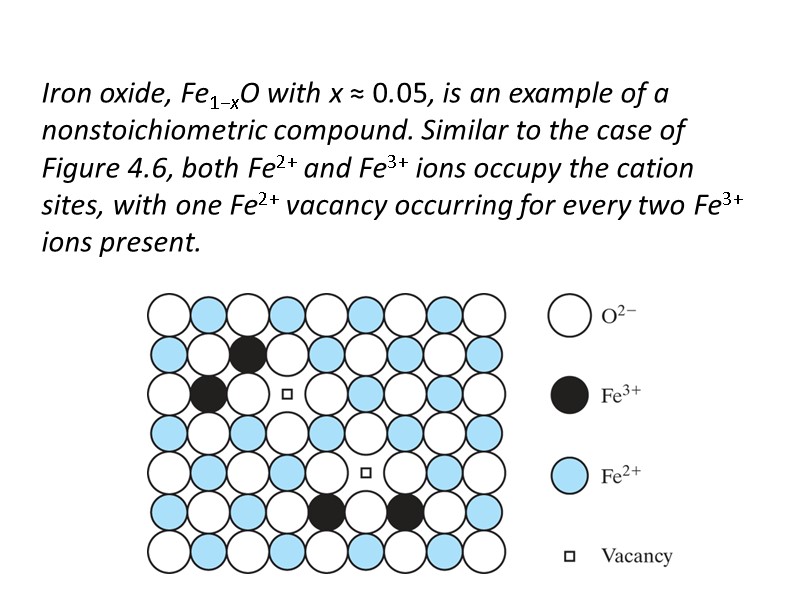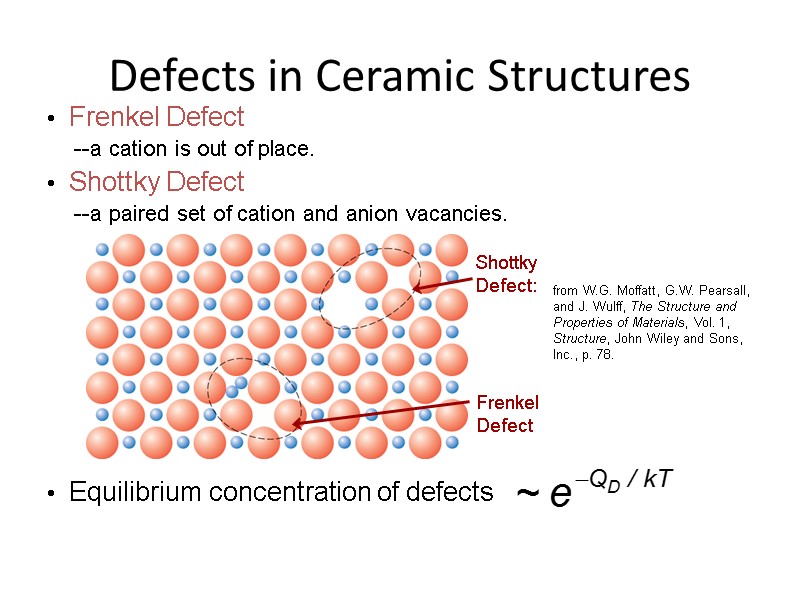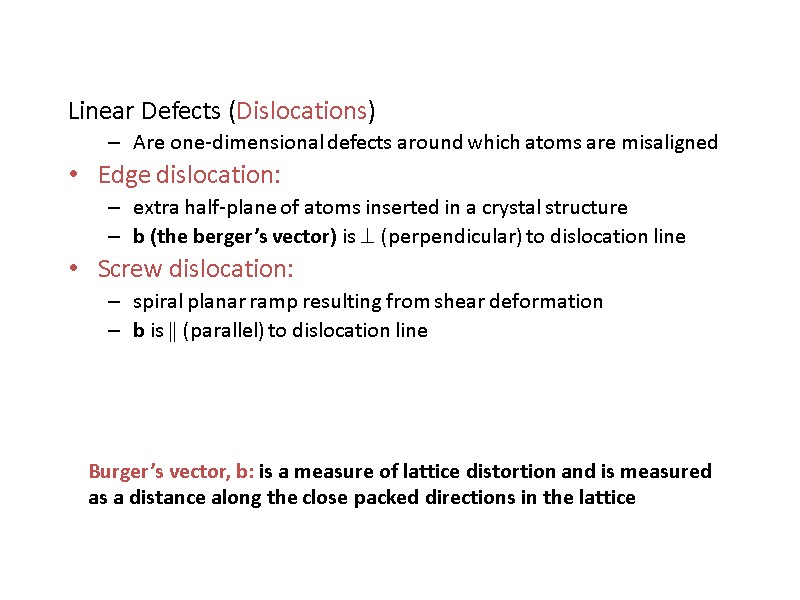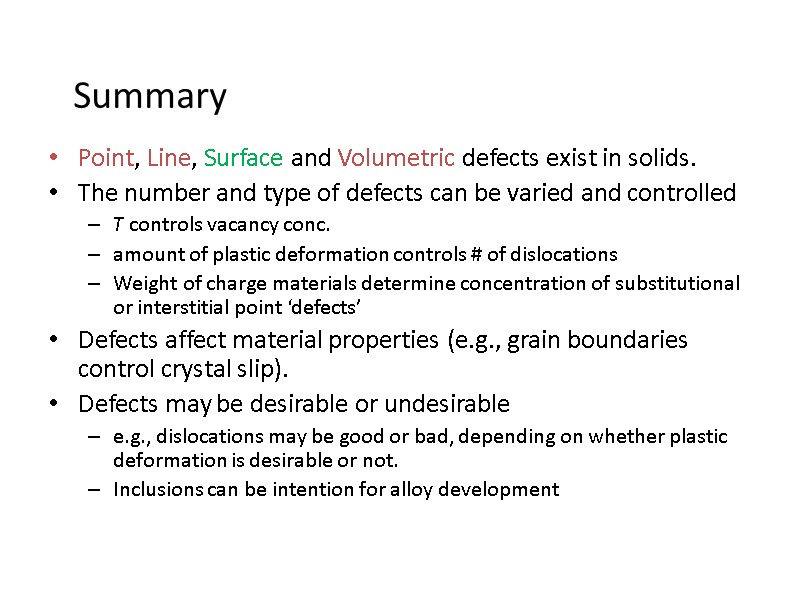Chapter 4 Crystal Defects and Noncrystalline Structure–Imperfection ME













































24842-crystal_imperfection_ch_4.ppt
- Количество слайдов: 44
 Chapter 4 Crystal Defects and Noncrystalline Structure–Imperfection ME 2105 – Dr. Lindeke
Chapter 4 Crystal Defects and Noncrystalline Structure–Imperfection ME 2105 – Dr. Lindeke
 In our pervious Lecture when discussing Crystals we ASSUMED PERFECT ORDER In real materials we find: Crystalline Defects or lattice irregularity Most real materials have one or more “errors in perfection” with dimensions on the order of an atomic diameter to many lattice sites Defects can be classification: 1. according to geometry (point, line or plane) 2. dimensions of the defect
In our pervious Lecture when discussing Crystals we ASSUMED PERFECT ORDER In real materials we find: Crystalline Defects or lattice irregularity Most real materials have one or more “errors in perfection” with dimensions on the order of an atomic diameter to many lattice sites Defects can be classification: 1. according to geometry (point, line or plane) 2. dimensions of the defect
 Forming a liquid solution of water and alcohol. Mixing occurs on the molecular scale. We can define this mixture/solution on a weight or “atomic” basis A similar discussion can apply to “mixtures” of metals – called alloys
Forming a liquid solution of water and alcohol. Mixing occurs on the molecular scale. We can define this mixture/solution on a weight or “atomic” basis A similar discussion can apply to “mixtures” of metals – called alloys
 • Vacancies: -vacant atomic sites in a structure. • Self-Interstitials: -"extra" atoms positioned between atomic sites. Point Defects – in the solid state are more predictable
• Vacancies: -vacant atomic sites in a structure. • Self-Interstitials: -"extra" atoms positioned between atomic sites. Point Defects – in the solid state are more predictable
 POINT DEFECTS The simplest of the point defect is a vacancy, or vacant lattice site. All crystalline solids contain vacancies. Principles of thermodynamics is used explain the necessity of the existence of vacancies in crystalline solids. The presence of vacancies increases the entropy (randomness) of the crystal. The equilibrium number of vacancies for a given quantity of material depends on and increases with temperature as follows: (an Arrhenius model) Nv= N exp(-Qv/kT) Equilibrium no. of vacancies Total no. of atomic sites Energy required to form vacancy T = absolute temperature in Kelvin k = gas or Boltzmann’s constant
POINT DEFECTS The simplest of the point defect is a vacancy, or vacant lattice site. All crystalline solids contain vacancies. Principles of thermodynamics is used explain the necessity of the existence of vacancies in crystalline solids. The presence of vacancies increases the entropy (randomness) of the crystal. The equilibrium number of vacancies for a given quantity of material depends on and increases with temperature as follows: (an Arrhenius model) Nv= N exp(-Qv/kT) Equilibrium no. of vacancies Total no. of atomic sites Energy required to form vacancy T = absolute temperature in Kelvin k = gas or Boltzmann’s constant
 Two outcomes if impurity (B) added to host (A): • Solid solution of B in A (i.e., random dist. of point defects) • Solid solution of B in A plus particles of a new phase (usually for a larger amount of B) OR Substitutional solid soln. (e.g., Cu in Ni) Interstitial solid soln. (e.g., C in Fe) Second phase particle --different composition --often different structure. Point Defects in Alloys
Two outcomes if impurity (B) added to host (A): • Solid solution of B in A (i.e., random dist. of point defects) • Solid solution of B in A plus particles of a new phase (usually for a larger amount of B) OR Substitutional solid soln. (e.g., Cu in Ni) Interstitial solid soln. (e.g., C in Fe) Second phase particle --different composition --often different structure. Point Defects in Alloys
 Solid solution of nickel in copper shown along a (100) plane. This is a substitutional solid solution with nickel atoms substituting for copper atoms on fcc atom sites.
Solid solution of nickel in copper shown along a (100) plane. This is a substitutional solid solution with nickel atoms substituting for copper atoms on fcc atom sites.
 Imperfections in Solids Conditions for substitutional solid solution (S.S.) Hume – Rothery rules 1. r (atomic radius) < 15% 2. Proximity in periodic table i.e., similar electronegativities 3. Same crystal structure for pure metals 4. Valency equality All else being equal, a metal will have a greater tendency to dissolve a metal of higher valency than one of lower valency (it provides more electrons to the “cloud”)
Imperfections in Solids Conditions for substitutional solid solution (S.S.) Hume – Rothery rules 1. r (atomic radius) < 15% 2. Proximity in periodic table i.e., similar electronegativities 3. Same crystal structure for pure metals 4. Valency equality All else being equal, a metal will have a greater tendency to dissolve a metal of higher valency than one of lower valency (it provides more electrons to the “cloud”)
 Imperfections in Solids Application of Hume–Rothery rules – Solid Solutions 1. Would you predict more Al or Ag to dissolve in Zn? 2. More Zn or Al in Cu? Table on p. 106, Callister 7e. More Al because size is closer and val. Is higher – but not too much because of structural differences – FCC in HCP Surely Zn since size is closer thus causing lower distortion (4% vs 12%)
Imperfections in Solids Application of Hume–Rothery rules – Solid Solutions 1. Would you predict more Al or Ag to dissolve in Zn? 2. More Zn or Al in Cu? Table on p. 106, Callister 7e. More Al because size is closer and val. Is higher – but not too much because of structural differences – FCC in HCP Surely Zn since size is closer thus causing lower distortion (4% vs 12%)
 Imperfections in Solids Specification of composition weight percent m1 = mass of component 1 nm1 = number of moles of component 1 atom percent
Imperfections in Solids Specification of composition weight percent m1 = mass of component 1 nm1 = number of moles of component 1 atom percent
 Wt. % and At. % -- An example
Wt. % and At. % -- An example
 Converting Between: (Wt% and At%) Converts from wt% to At% (Ai is atomic weight) Converts from at% to wt% (Ai is atomic weight)
Converting Between: (Wt% and At%) Converts from wt% to At% (Ai is atomic weight) Converts from at% to wt% (Ai is atomic weight)
 Interstitial solid solution applies to carbon in α-iron. The carbon atom is small enough to fit with some strain in the interstice (or opening) among adjacent Fe atoms in this important steel structure. [This unit-cell structure can be compared with that shown in Figure 3.4b.] But the interstitial solubility is quite low since the size mismatch of the site to the radius of a carbon atom is only about 1/4
Interstitial solid solution applies to carbon in α-iron. The carbon atom is small enough to fit with some strain in the interstice (or opening) among adjacent Fe atoms in this important steel structure. [This unit-cell structure can be compared with that shown in Figure 3.4b.] But the interstitial solubility is quite low since the size mismatch of the site to the radius of a carbon atom is only about 1/4
 Random, substitution solid solution can occur in Ionic Crystalline materials as well. Here of NiO in MgO. The O2− arrangement is unaffected. The substitution occurs among Ni2+ and Mg2+ ions.
Random, substitution solid solution can occur in Ionic Crystalline materials as well. Here of NiO in MgO. The O2− arrangement is unaffected. The substitution occurs among Ni2+ and Mg2+ ions.
 A substitution solid solution of Al2O3 in MgO is not as simple as the case of NiO in MgO. The requirement of charge neutrality in the overall compound permits only two Al3+ ions to fill every threeMg2+ vacant sites, leaving oneMg2+ vacancy.
A substitution solid solution of Al2O3 in MgO is not as simple as the case of NiO in MgO. The requirement of charge neutrality in the overall compound permits only two Al3+ ions to fill every threeMg2+ vacant sites, leaving oneMg2+ vacancy.
 Iron oxide, Fe1−xO with x ≈ 0.05, is an example of a nonstoichiometric compound. Similar to the case of Figure 4.6, both Fe2+ and Fe3+ ions occupy the cation sites, with one Fe2+ vacancy occurring for every two Fe3+ ions present.
Iron oxide, Fe1−xO with x ≈ 0.05, is an example of a nonstoichiometric compound. Similar to the case of Figure 4.6, both Fe2+ and Fe3+ ions occupy the cation sites, with one Fe2+ vacancy occurring for every two Fe3+ ions present.
 • Frenkel Defect --a cation is out of place. • Shottky Defect --a paired set of cation and anion vacancies. • Equilibrium concentration of defects from W.G. Moffatt, G.W. Pearsall, and J. Wulff, The Structure and Properties of Materials, Vol. 1, Structure, John Wiley and Sons, Inc., p. 78. Defects in Ceramic Structures
• Frenkel Defect --a cation is out of place. • Shottky Defect --a paired set of cation and anion vacancies. • Equilibrium concentration of defects from W.G. Moffatt, G.W. Pearsall, and J. Wulff, The Structure and Properties of Materials, Vol. 1, Structure, John Wiley and Sons, Inc., p. 78. Defects in Ceramic Structures
 And: • slip between crystal planes result when dislocations move, • this motion produces permanent (plastic) deformation. Are called Dislocations: Schematic of Zinc (HCP): • before deformation • after tensile elongation slip steps which are the physical evidence of large numbers of dislocations slipping along the close packed plane {0001} Line Defects Adapted from Fig. 7.8, Callister 7e.
And: • slip between crystal planes result when dislocations move, • this motion produces permanent (plastic) deformation. Are called Dislocations: Schematic of Zinc (HCP): • before deformation • after tensile elongation slip steps which are the physical evidence of large numbers of dislocations slipping along the close packed plane {0001} Line Defects Adapted from Fig. 7.8, Callister 7e.
 Linear Defects (Dislocations) Are one-dimensional defects around which atoms are misaligned Edge dislocation: extra half-plane of atoms inserted in a crystal structure b (the berger’s vector) is (perpendicular) to dislocation line Screw dislocation: spiral planar ramp resulting from shear deformation b is (parallel) to dislocation line Burger’s vector, b: is a measure of lattice distortion and is measured as a distance along the close packed directions in the lattice
Linear Defects (Dislocations) Are one-dimensional defects around which atoms are misaligned Edge dislocation: extra half-plane of atoms inserted in a crystal structure b (the berger’s vector) is (perpendicular) to dislocation line Screw dislocation: spiral planar ramp resulting from shear deformation b is (parallel) to dislocation line Burger’s vector, b: is a measure of lattice distortion and is measured as a distance along the close packed directions in the lattice
 Edge Dislocation Fig. 4.3, Callister 7e. Edge Dislocation
Edge Dislocation Fig. 4.3, Callister 7e. Edge Dislocation
 Definition of the Burgers vector, b, relative to an edge dislocation. (a) In the perfect crystal, an m× n atomic step loop closes at the starting point. (b) In the region of a dislocation, the same loop does not close, and the closure vector (b) represents the magnitude of the structural defect. For the edge dislocation, the Burgers vector is perpendicular to the dislocation line.
Definition of the Burgers vector, b, relative to an edge dislocation. (a) In the perfect crystal, an m× n atomic step loop closes at the starting point. (b) In the region of a dislocation, the same loop does not close, and the closure vector (b) represents the magnitude of the structural defect. For the edge dislocation, the Burgers vector is perpendicular to the dislocation line.
 Screw dislocation. The spiral stacking of crystal planes leads to the Burgers vector being parallel to the dislocation line.
Screw dislocation. The spiral stacking of crystal planes leads to the Burgers vector being parallel to the dislocation line.
 Mixed dislocation. This dislocation has both edge and screw character with a single Burgers vector consistent with the pure edge and pure screw regions.
Mixed dislocation. This dislocation has both edge and screw character with a single Burgers vector consistent with the pure edge and pure screw regions.
 Burgers vector for the aluminum oxide structure. The large repeat distance in this relatively complex structure causes the Burgers vector to be broken up into two (for O2−) or four (for Al3+) partial dislocations, each representing a smaller slip step. This complexity is associated with the brittleness of ceramics compared with metals. (From W. D. Kingery, H. K. Bowen, and D. R. Uhlmann, Introduction to Ceramics, 2nd ed., John Wiley & Sons, Inc., New York, 1976.)
Burgers vector for the aluminum oxide structure. The large repeat distance in this relatively complex structure causes the Burgers vector to be broken up into two (for O2−) or four (for Al3+) partial dislocations, each representing a smaller slip step. This complexity is associated with the brittleness of ceramics compared with metals. (From W. D. Kingery, H. K. Bowen, and D. R. Uhlmann, Introduction to Ceramics, 2nd ed., John Wiley & Sons, Inc., New York, 1976.)
 Imperfections in Solids Dislocations are visible in (T) electron micrographs Adapted from Fig. 4.6, Callister 7e.
Imperfections in Solids Dislocations are visible in (T) electron micrographs Adapted from Fig. 4.6, Callister 7e.
 Dislocations & Crystal Structures • Structure: close-packed planes & directions are preferred. view onto two close-packed planes. close-packed plane (bottom) close-packed plane (top) close-packed directions • Comparison among crystal structures: FCC: many close-packed planes/directions; HCP: only one plane, 3 directions; BCC: none “super-close” many “near close” • Specimens that were tensile tested. Mg (HCP) Al (FCC) tensile direction
Dislocations & Crystal Structures • Structure: close-packed planes & directions are preferred. view onto two close-packed planes. close-packed plane (bottom) close-packed plane (top) close-packed directions • Comparison among crystal structures: FCC: many close-packed planes/directions; HCP: only one plane, 3 directions; BCC: none “super-close” many “near close” • Specimens that were tensile tested. Mg (HCP) Al (FCC) tensile direction
 One case is a twin boundary (plane) Essentially a reflection of atom positions across the twinning plane. Stacking faults For FCC metals an error in ABCABC packing sequence Ex: ABCABABC Planar Defects in Solids Adapted from Fig. 4.9, Callister 7e.
One case is a twin boundary (plane) Essentially a reflection of atom positions across the twinning plane. Stacking faults For FCC metals an error in ABCABC packing sequence Ex: ABCABABC Planar Defects in Solids Adapted from Fig. 4.9, Callister 7e.
 Simple view of the surface of a crystalline material.
Simple view of the surface of a crystalline material.
 A more detailed model of the elaborate ledgelike structure of the surface of a crystalline material. Each cube represents a single atom. [From J. P. Hirth and G. M. Pound, J. Chem. Phys. 26, 1216 (1957).]
A more detailed model of the elaborate ledgelike structure of the surface of a crystalline material. Each cube represents a single atom. [From J. P. Hirth and G. M. Pound, J. Chem. Phys. 26, 1216 (1957).]
 Typical optical micrograph of a grain structure, 100×. The material is a low-carbon steel. The grain boundaries have been lightly etched with a chemical solution so that they reflect light differently from the polished grains, thereby giving a distinctive contrast. (From Metals Handbook, 8th ed., Vol. 7: Atlas of Microstructures of Industrial Alloys, American Society for Metals, Metals Park, OH, 1972.)
Typical optical micrograph of a grain structure, 100×. The material is a low-carbon steel. The grain boundaries have been lightly etched with a chemical solution so that they reflect light differently from the polished grains, thereby giving a distinctive contrast. (From Metals Handbook, 8th ed., Vol. 7: Atlas of Microstructures of Industrial Alloys, American Society for Metals, Metals Park, OH, 1972.)
 Simple grain-boundary structure. This is termed a tilt boundary because it is formed when two adjacent crystalline grains are tilted relative to each other by a few degrees (θ). The resulting structure is equivalent to isolated edge dislocations separated by the distance b/θ, where b is the length of the Burgers vector, b. (From W. T. Read, Dislocations in Crystals, McGraw-Hill Book Company, New York, 1953. Reprinted with permission of the McGraw-Hill Book Company.)
Simple grain-boundary structure. This is termed a tilt boundary because it is formed when two adjacent crystalline grains are tilted relative to each other by a few degrees (θ). The resulting structure is equivalent to isolated edge dislocations separated by the distance b/θ, where b is the length of the Burgers vector, b. (From W. T. Read, Dislocations in Crystals, McGraw-Hill Book Company, New York, 1953. Reprinted with permission of the McGraw-Hill Book Company.)
 The ledge Growth leads to structures with Grain Boundries The shape and average size or diameter of the grains for some polycrystalline specimens are large enough to observe with the unaided eye. (Macrosocipic examination)
The ledge Growth leads to structures with Grain Boundries The shape and average size or diameter of the grains for some polycrystalline specimens are large enough to observe with the unaided eye. (Macrosocipic examination)
 Specimen for the calculation of the grain-size number, G is defined at a magnification of 100×. This material is a low-carbon steel similar to that shown in Figure 4.18. (From Metals Handbook, 8th ed., Vol. 7: Atlas of Microstructures of Industrial Alloys, American Society for Metals, Metals Park, OH, 1972.)
Specimen for the calculation of the grain-size number, G is defined at a magnification of 100×. This material is a low-carbon steel similar to that shown in Figure 4.18. (From Metals Handbook, 8th ed., Vol. 7: Atlas of Microstructures of Industrial Alloys, American Society for Metals, Metals Park, OH, 1972.)
 • Useful up to 2000X magnification (?). • Polishing removes surface features (e.g., scratches) • Etching changes reflectance, depending on crystal orientation since different Xtal planes have different reactivity. Micrograph of brass (a Cu-Zn alloy) Optical Microscopy Courtesy of J.E. Burke, General Electric Co. crystallographic planes
• Useful up to 2000X magnification (?). • Polishing removes surface features (e.g., scratches) • Etching changes reflectance, depending on crystal orientation since different Xtal planes have different reactivity. Micrograph of brass (a Cu-Zn alloy) Optical Microscopy Courtesy of J.E. Burke, General Electric Co. crystallographic planes
 Since Grain boundaries... • are planer imperfections, • are more susceptible to etching, • may be revealed as dark lines, • relate change in crystal orientation across boundary. (courtesy of L.C. Smith and C. Brady, the National Bureau of Standards, Washington, DC [now the National Institute of Standards and Technology, Gaithersburg, MD].) Optical Microscopy ASTM grain size number N = 2 G - 1 number of grains/in2 at 100x magnification
Since Grain boundaries... • are planer imperfections, • are more susceptible to etching, • may be revealed as dark lines, • relate change in crystal orientation across boundary. (courtesy of L.C. Smith and C. Brady, the National Bureau of Standards, Washington, DC [now the National Institute of Standards and Technology, Gaithersburg, MD].) Optical Microscopy ASTM grain size number N = 2 G - 1 number of grains/in2 at 100x magnification
 ASTM (American Society for testing and Materials) VISUAL CHARTS (@100x) each with a number Quick and easy – used for steel ASTM has prepared several standard comparison charts, all having different average grain sizes. To each is assigned a number from 1 to 10, which is termed the grain size number; the larger this number, the smaller the grains. NOTE: The ASTM grain size is related (or relates) a grain area AT 100x MAGNIFICATION
ASTM (American Society for testing and Materials) VISUAL CHARTS (@100x) each with a number Quick and easy – used for steel ASTM has prepared several standard comparison charts, all having different average grain sizes. To each is assigned a number from 1 to 10, which is termed the grain size number; the larger this number, the smaller the grains. NOTE: The ASTM grain size is related (or relates) a grain area AT 100x MAGNIFICATION
 Determining Grain Size, using a micrograph taken at 300x We count 14 grains in a 1 in2 area on the (300x) image To report ASTM grain size we needed a measure of N at 100x not 300x We need a conversion method!
Determining Grain Size, using a micrograph taken at 300x We count 14 grains in a 1 in2 area on the (300x) image To report ASTM grain size we needed a measure of N at 100x not 300x We need a conversion method!
 For this same material, how many Grains would I expect /in2 at 100x? At 50x?
For this same material, how many Grains would I expect /in2 at 100x? At 50x?
 At 100x
At 100x
 Two-dimensional schematics give a comparison of (a) a crystalline oxide and (b) a non-crystalline oxide. The non-crystalline material retains short-range order (the triangularly coordinated building block), but loses long-range order (crystallinity). This illustration was also used to define glass in Chapter 1 (Figure 1.8).
Two-dimensional schematics give a comparison of (a) a crystalline oxide and (b) a non-crystalline oxide. The non-crystalline material retains short-range order (the triangularly coordinated building block), but loses long-range order (crystallinity). This illustration was also used to define glass in Chapter 1 (Figure 1.8).
 Bernal model of an amorphous metal structure. The irregular stacking of atoms is represented as a connected set of polyhedra. Each polyhedron is produced by drawing lines between the centers of adjacent atoms. Such polyhedra are irregular in shape and the stacking is not repetitive.
Bernal model of an amorphous metal structure. The irregular stacking of atoms is represented as a connected set of polyhedra. Each polyhedron is produced by drawing lines between the centers of adjacent atoms. Such polyhedra are irregular in shape and the stacking is not repetitive.
 A chemical impurity such as Na+ is a glass modifier, breaking up the random network and leaving nonbridging oxygen ions. [From B. E. Warren, J. Am. Ceram. Soc. 24, 256 (1941).]
A chemical impurity such as Na+ is a glass modifier, breaking up the random network and leaving nonbridging oxygen ions. [From B. E. Warren, J. Am. Ceram. Soc. 24, 256 (1941).]
 Schematic illustration of medium-range ordering in a CaO–SiO2 glass. Edge-sharing CaO6 octahedra have been identified by neutron-diffraction experiments. [From P. H. Gaskell et al., Nature 350, 675 (1991).]
Schematic illustration of medium-range ordering in a CaO–SiO2 glass. Edge-sharing CaO6 octahedra have been identified by neutron-diffraction experiments. [From P. H. Gaskell et al., Nature 350, 675 (1991).]
 Summary Point, Line, Surface and Volumetric defects exist in solids. The number and type of defects can be varied and controlled T controls vacancy conc. amount of plastic deformation controls # of dislocations Weight of charge materials determine concentration of substitutional or interstitial point ‘defects’ Defects affect material properties (e.g., grain boundaries control crystal slip). Defects may be desirable or undesirable e.g., dislocations may be good or bad, depending on whether plastic deformation is desirable or not. Inclusions can be intention for alloy development
Summary Point, Line, Surface and Volumetric defects exist in solids. The number and type of defects can be varied and controlled T controls vacancy conc. amount of plastic deformation controls # of dislocations Weight of charge materials determine concentration of substitutional or interstitial point ‘defects’ Defects affect material properties (e.g., grain boundaries control crystal slip). Defects may be desirable or undesirable e.g., dislocations may be good or bad, depending on whether plastic deformation is desirable or not. Inclusions can be intention for alloy development

